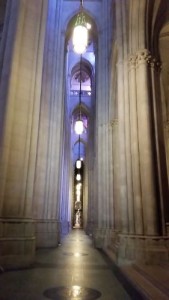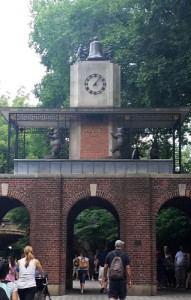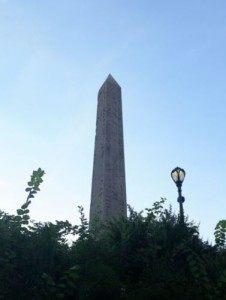I have just shown myself that I can, in fact, read and write up an entire issue before I ran out of writeups from my old blog. I am writing this, for what it’s worth, on August 15, 2015, several weeks before it will go live on my blog. Following my old pattern, I should write up April 2014 next, but I cannot find that issue at the moment. Therefore, I will go on to March 2014 next.
It’s Time for a Conversation, by Joshua Foer, photographs by Brian Sherry
It’s Time for a Conversation follows several researchers into dolphin language. Dolphins vocalize and some believe that these vocalizations are a language. For example, when two dolphins at the Roatan Institute for the Marine Sciences are given a signal that means “tandem,” the two dolphins are to do a behavior in unison. The dolphins will go under the water and whistle at each other, then they will do the same behavior together. Are they playing a very sophisticated game of “follow the leader,” or are the sounds they exchange actually communicating a plan?
So far, scientists have not been able to find much in the way of meaning in the chirps and whistles of dolphins. They have been able to determine that dolphins give themselves names while they are calves. For the rest of their lives, if one dolphin uses the call that the dolphin chose as his or her name, that dolphin will respond. Beyond that, there has not been much progress.
It is possible that their intelligence is so different from ours that we will never be able to learn to “speak dolphin.” However, if it is possible for us to learn their language, someone, somewhere is bound to figure it out.
This article has one of my favorite photographs so far in this project. The opening image, on pages 30 and 31 of the issue, there is a photograph of spinner dolphins in Hawaii. The water is perfectly clear and what I assume is the bottom of the ocean is white, and looks more like clouds than sand. This is fairly disorienting, in a pleasant way, and gives me the impression that they are not swimming, but flying. Or, maybe they are flying.
Taking Back Detroit, by Susan Ager, photographs by Wayne Lawrence
In Taking Back Detroit, Ager writes about the attempt of some brave souls to bring the dying city of Detroit back to life. We start out with Anthony Hatinger, who is setting up a tilapia farm in a former liquor store. The Tilapia live in the basement and the water is pumped upstairs, where the fishes’ waste feeds the plants of an indoor garden. The garden consists largely of green leafy vegetables. Once the waste has been removed by the plants, the now-clean water flows back down to the fish in the basement.
And he is just one of many people who are breathing new life into the city. Ager is a journalist who grew up in Detroit and spent the first 25 years of her career there, so this topic is very personal to her.
The fate of Detroit is not nearly as important to me as it is to Ager. In a global sense, Chicago and Detroit are in the same region, but in a practical sense, they are really very far apart and I have only ever been to Detroit twice, once in the 1981 and once in 1987. My mom and I were appalled by the decline in such a short amount of time. So, for me, reading about Hatinger, and about John Hantz, who invested four million dollars in improving the lives of Detroiters by buying up empty lots and planting trees in them, were heartening to me. Green space is an issue dear to my heart anyhow (you will see a lot of posts on parks and other green spaces in my writing. Green space is important to the psychological well-being of people, and the people of Detroit need things that are helpful psychologically.
The work is just starting however. The schools of Detroit are still not performing as well as they should, and Detroit still has a disgraceful level of unemployment. And yet, people are moving into the city and helping to bring jobs and money into the city. And hopefully, with those jobs and money, what was once known as “The Paris of the Midwest” will someday, perhaps even someday soon, have a Renaissance of its own.
Quest for a Superbee, by Charles C. Mann, photographs by Anand Varma
In this era of colony collapse disorder many are worried about the future survival of the honeybee. Colony collapse disorder. is not one problem, but many. Some colonies die off because of the increase in chemical pesticides, but others are killed by disease, and still others by pests. Some colonies don’t die at all, but habitat loss causes them to move elsewhere.
This is not the first time bee colonies have died off in large numbers. Most recently, exactly 100 years ago this year, a virus wiped out hundreds of bee colonies. A young monk known as Brother Adam traveled the world looking for bees and eventually bred was became known as the Buckfast Bee. The problem is more complex now, since there are so many other causes, but if Brother Adam was able to breed a bee that would survive the virus, it may well be possible to breed, or genetically engineer a bee that will survive current threats.
Quest for a Superbee outlines some of the projects being done, in breeding, in genetic engineering, even the possibility of robotic bees — tiny drones that will fly into a field and pollinate the flowers. Some, however, think that nature will find a way and that, despite more significant losses, bees will become naturally resistant to the threats that are killing them off today. I say that so long as the new bees are tested properly in a closed environment before setting them loose in the outdoors, any and all possible solutions are welcome. If genetically engineered bees are what we need to get through until the honeybee evolves enough to survive current threats, then that is what we should do.
Harnessing the Mekong or Killing It? by Michelle Nijhuis, photographs by David Guttenfelder
Over the last 20 or so years, the nations that the Mekong River flows through, China, Myanmar, Thailand, Laos, Cambodia, and Vietnam, have been damming the river in hopes of increasing the prosperity of these nations through the generation of electricity. And the “generating electricity” part seems to be working. The “increasing prosperity part” could use some work.
You see, the people who have lived along the Mekong for generations rely on the river for food, including fish and rice, and the number of fish in the river has dropped from levels that existed prior to the dams being built. Added to this is the threat of flooding. When it rains heavily upstream, the water has to go somewhere, and that “somewhere” is the villages alongside the river.
The lack of prosperity doesn’t end there. The governments and companies that have been building the dams are making lots of money by selling the power generated to other countries. Very little of the power generated is used by those in their own countries. Almost no one in Cambodia has electricity because the power generated in a way that will basically be free once the dam is paid for, is too expensive for the populace.
Can anything be done? Water experts and other ecologists would like to see development of the dams slowed down and planned better. Dams are being built haphazardly by each nation without regard for what the nearby nations are doing. There are places that the dams could be put where it would have minimal impact on those who live in the area, but it looks unlikely that the governments will work together for the good of their citizens any time soon.
Walking the Way, story and photographs by Michael George
Walking the Way is words and photographs about George’s trip down the Way of St. James (Camino de Santiago, in Spanish), a route that goes from France through Spain to Santiago de Compostela, a cathedral in Spain which is rumored to hold the remains of the Apostle James the son of Zebedee (as distinct from James the son of Alphaeus and also James the brother of Jesus).
The Way of St. James was originally a purely religious pilgrimage, but in modern times, 60 percent of those who walk it walk for nonreligious reasons, such as to get space from their daily lives or to contemplate a change in their lives.
For some reason, George specified that he walked the Way in the summers of 2012 and 2013. I had to dig up more information on this. Did George take the trip in two parts (which seems like cheating) or did he do it twice? Apparently, he did the walk twice. The first time, he was just out of college and facing a change in his life status and so he did the walk as a pilgrim. Then he returned a year later to meet the people and photograph his journey. The results of this second trip are largely what we see in this article.



